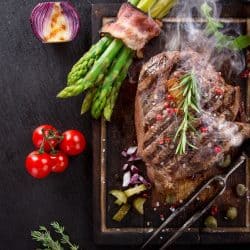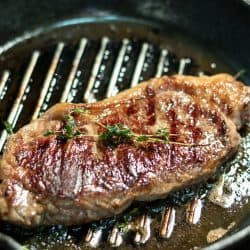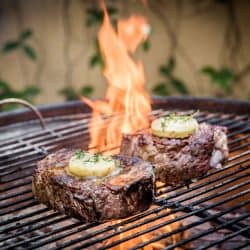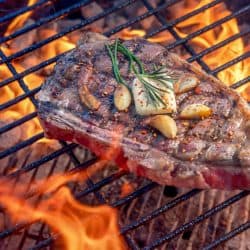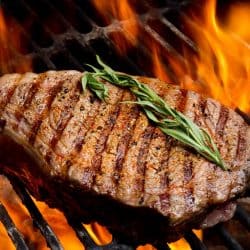If you’re an unabashed carnivore, then you should be familiar with the satisfying sound of a good steak sear. However, if you notice a rancid smell from your smoking pan, there’s a good chance you’re using the wrong cooking oil. Not all oils can handle high temperatures, which means not all are fit to be used for searing. Thankfully, we’ve done all the research to help take the guesswork out of choosing the perfect oil for searing steaks.
Since searing takes place at high temperatures, you need to choose an oil with a high smoke point. Here are a few of the best choices for searing steaks:
- Safflower oil
- Canola oil
- Vegetable oil
- Peanut oil
- Soybean oil
- Rice bran oil
- Sunflower oil
Are you still struggling to achieve that perfect sear? If so, you’ve got to check out all of our searing techniques below.
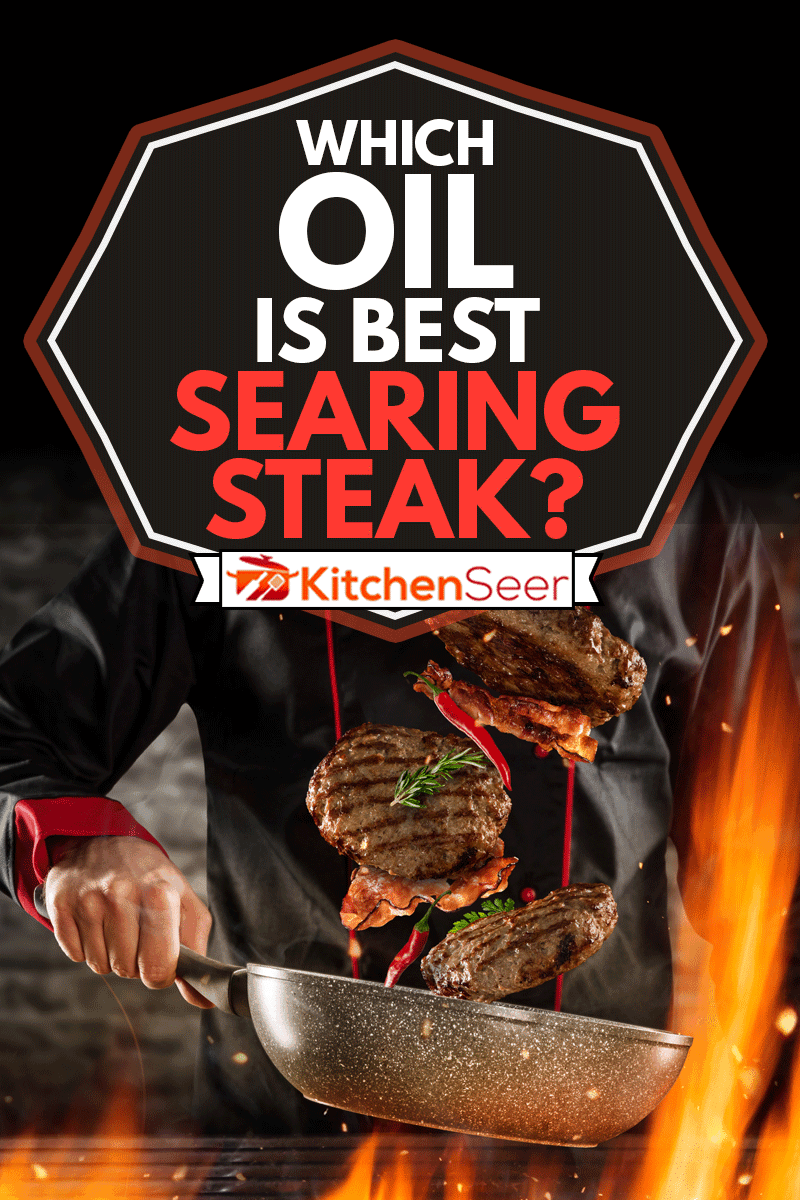
What Is Searing And Why Should You Do It?
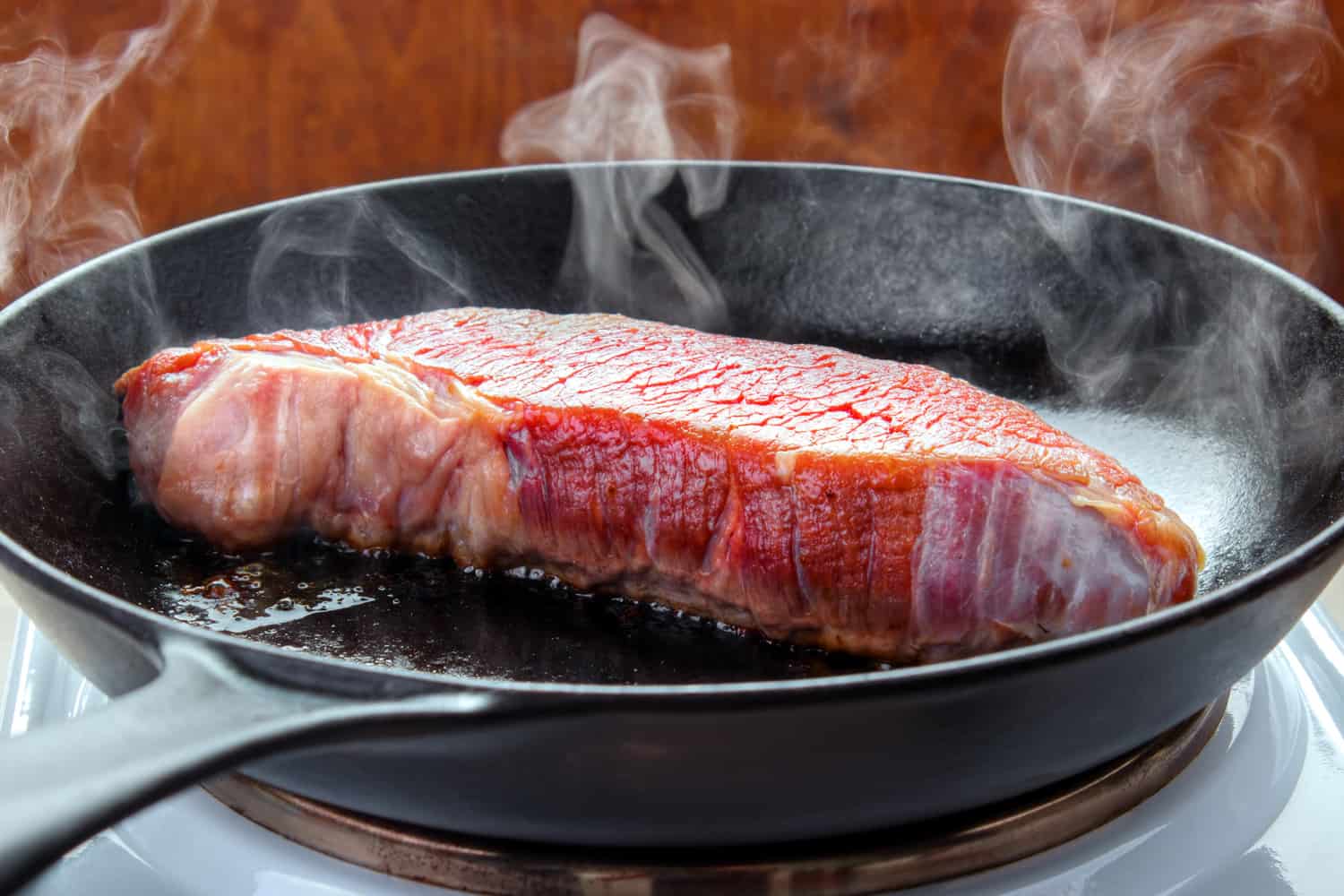
Before we get into searing strategies, you may be wondering what in the world searing is. Simply put, searing involves placing meat on a screaming hot pan to create a crusty, brown surface. If you want to get technical, this technique takes advantage of the fancy-sounding “Maillard reaction,” which creates a distinctive brown layer.
So, why do people sear their steaks? One theory is that searing helps to preserve all of your meat’s juicy flavors. However, recent research proves that searing removes moisture from your favorite cut. Even with this flavor loss, most chefs swear by searing for these three reasons:
- Searing creates a crusty outer layer that provides a lovely contrast to the smooth interior.
- The brown bits that cling to the bottom of your pan (aka “the fond”) are essential for making steak sauces.
- Seared steaks look prettier than un-seared cuts (and we all eat with our eyes first!).
What Are The Best Oils For Searing Steak?
To properly sear a steak, you need an extremely hot pan. Hence, the best cooking oils are those that have the highest smoke point. Even at extreme temperatures, these oils will not produce noxious carcinogens that can destroy your steak’s flavor.
According to the latest data, safflower oil has the highest smoke point at around 510° F.
Click here to see safflower oil on Amazon.
Although safflower oil is a fantastic choice, it’s not the most accessible cooking oil. Indeed, most people will have an easier time buying canola or vegetable oil, both of which are great for searing.
Click here to see canola oil on Amazon.
A few other neutral-flavored oils that are well above the 400° F smoke point level include:
- Rice bran oil
- Soybean oil
- Sunflower oil
- Corn oil
- Peanut oil
If you’re interested in learning more about oil smoke points, we suggest reading through our previous post examining What Kind Of Oil To Put In A Deep Fryer.
Is Extra Virgin Olive Oil Okay For Searing?

Please don’t use your expensive EVOO for searing steaks! One of the most significant drawbacks of using extra virgin olive oil is its low smoke point. It only takes about 350° F for most EVOO brands to start giving off a rancid odor.
While EVOO might not be suitable for searing, you should have no issues using refined olive oil. Unlike cold-pressed EVOO, refined olive oils have a lighter appearance and a higher smoke point. Often these olive oils are branded as “cooking oils” due to their greater heat resistance.
Click here to see this suitable olive oil on Amazon.
For more details on the do’s and don’ts of cooking with olive oil, be sure to check out our post on Using Olive Oils And Nonstick Pans.
Is Butter Good For Searing Steaks?
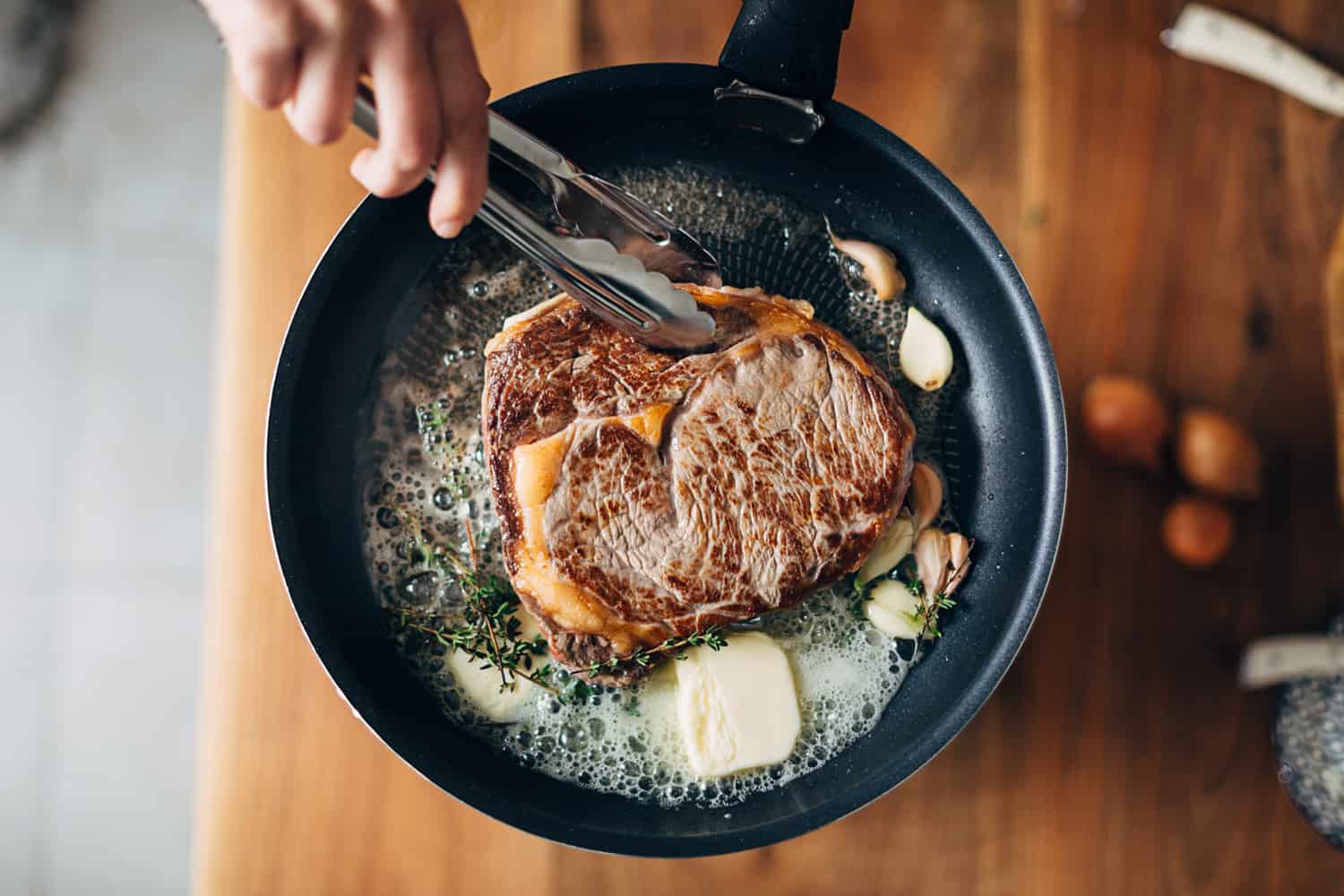
Along with EVOO, butter has a relatively low smoke point of around 325° F. Therefore, it’s not a good idea to place a slab of butter in your pan to sear your steaks.
However, since so many people love the taste that butter adds to their steak, they often place butter in the pan after their steak has a good sear. Alternatively, you could serve your steak with a side of butter.
It’s also worth mentioning that clarified butter has a higher smoke point than regular ol' butter. You could easily make clarified butter at home by placing unsalted butter in a pot over low heat and skimming off the milk solids.
Watch this video to learn how Martha Stewart’s staff makes clarified butter:
You could also buy India’s version of ultra-clarified butter (aka “ghee”) online. Just remember that clarified butter and ghee are not flavor neutral like the oils listed above.
Click here to see this ghee clarified butter on Amazon.
What Is The Best Way To Sear A Steak?
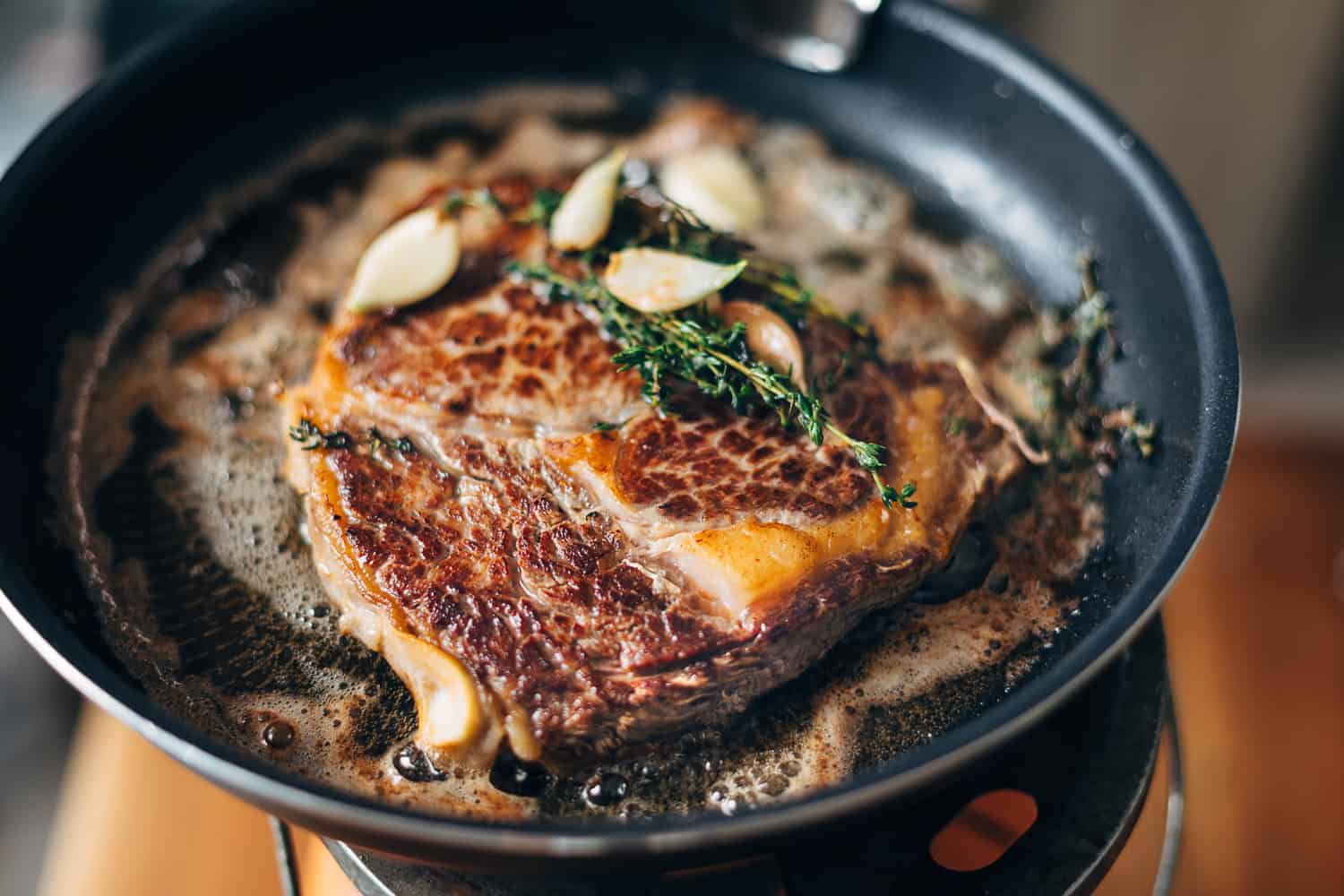
There are many different techniques on how to sear the perfect steak, but here are the basics:
- Take your steak out of the fridge at least 20 minutes before you’re ready to cook.
- When your steak is at room temperature, thoroughly dry it with paper towels.
- Season your steak generously with salt and pepper.
- Add a thin layer of your preferred oil to the pan.
- Turn your pan on high and wait for it to smoke.
- Slowly place the steak in the searing pan away from you.
- Flip the steak over every 30 – 45 seconds until you notice a brown outer coating.
While this is technically all you need to sear a steak, you might find it’s a bit bland. To add some flavor, most chefs add peeled garlic cloves, fresh thyme, and butter after a few minutes of searing. You can then baste your steak with the bubbling butter for phenomenal flavor.
After about five minutes of searing, many chefs put their steak in the oven until it reaches their desired “doneness.” However, people who like their steaks rare (like Gordon Ramsay!) could take these cuts out of the pan and serve as is.
Speaking of Gordon Ramsay, check out this popular video on his preferred searing technique:
What Pan To Use To Sear A Steak?
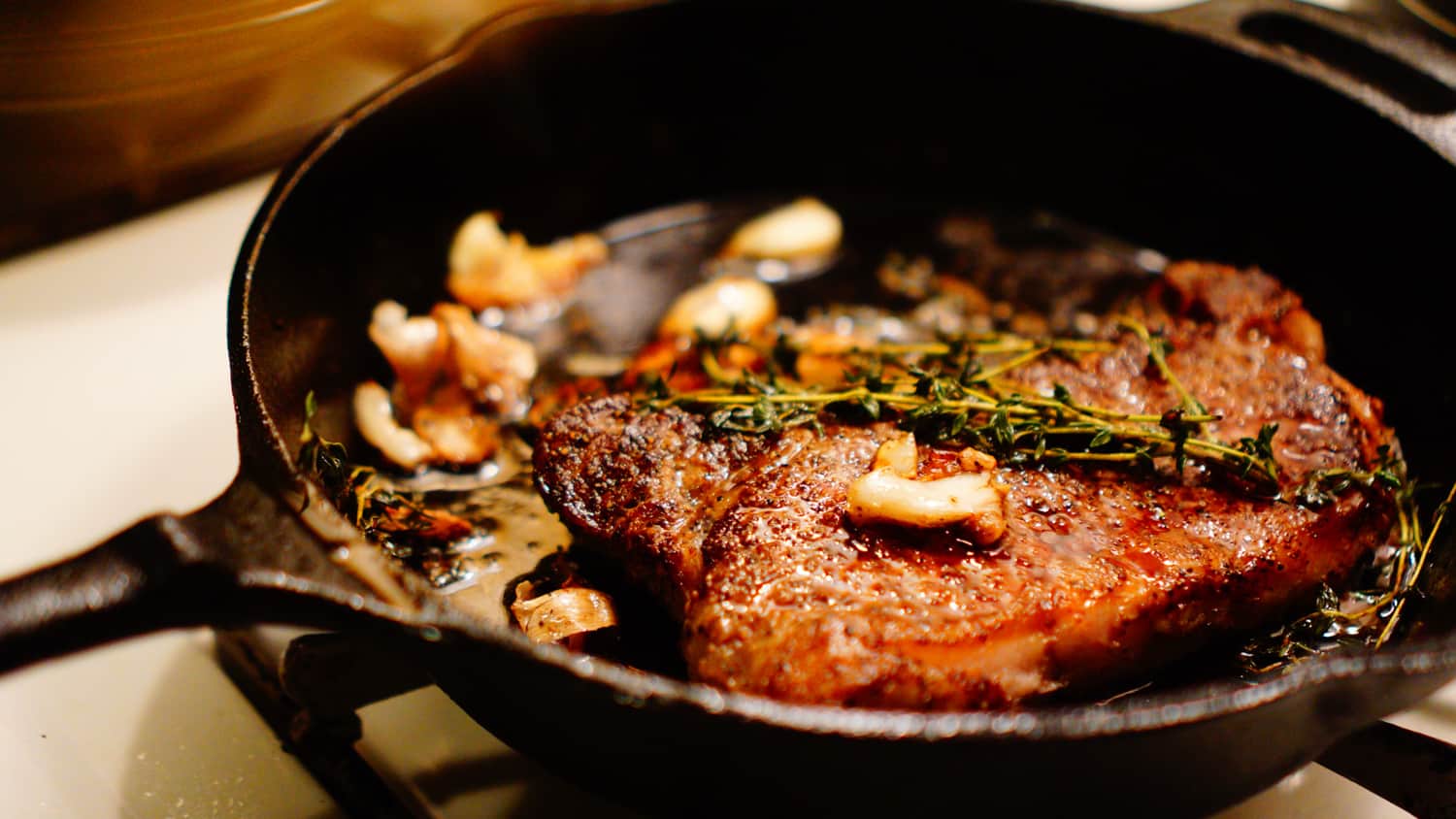
For the ultimate sear, you need a pan that can handle high heat without cracking. That’s why cast iron skillets are so widely used in the steak world. These heavy-duty pans can withstand a ton of heat, and they’re easy to pop into the oven.
Click here to see this cast iron skillet on Amazon.
If you don’t want a cast-iron skillet, another good second option is a stainless steel pan. Just double-check to see if your stainless steel pan is oven-safe before you bake with it.
Click here to see this stainless steel pan on Amazon.
While you could use a nonstick pan for cooking a steak, it's challenging to achieve a satisfying sear. If you put nonstick pans over extremely high temps, the Teflon coating will crack.
However, that doesn’t mean you can’t cook steaks on your nonstick pans. Be sure to read our post, Can You Cook A Steak In A Nonstick Pan? for more detailed info.
Is Seared Meat Cooked?
“Searing” and “cooking” are not interchangeable terms. If you want to be precise, "searing" only refers to cooking the outer layer of the steak. This is why most chefs place their steak in the oven for a few minutes after they’re done searing. Placing your steak in the oven helps preserve the golden-brown sear while bringing the internal temp to your desired level.
However, that doesn’t mean seared meat can’t be “cooked.” This is especially true if you like your steak on the rare side.
How Long To Bake A Steak After You Sear It?
Many factors influence how long to bake a steak, including your oven temperature and your preferred level of doneness. However, as a rule of thumb, it’s best to keep your seared steaks in a 425° F oven between 8 – 10 minutes.
According to the Certified Angus Beef Brand, the ideal internal temperatures for steak are as follows:
- Rare: 125° F
- Medium-Rare: 135° F
- Medium: 145° F
- Medium-Well: 155° F
- Well-Done: 160° F
However, please keep in mind that the USDA only recommends eating meat that registers at least 145° F. Anything below this level could be potentially unsafe to eat.
If you’re interested in learning more about using a food thermometer, please read through our post on Using A Meat Thermometer While Meat Is Cooking.
Sizzle Your Steaks Without Breaking The Smoke Point – Choosing The Right Oil For Searing
When you sear a steak, you want an oil that can withstand extreme temperatures. That’s why professional chefs most commonly use oils like safflower, vegetable, and canola. Be sure to stock up on one of these high-smoke point oils so you could satisfy your carnivore cravings any day of the week.







